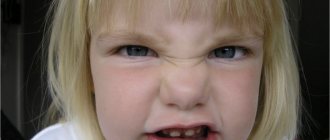Very often, in an impulse, parents cannot stand it and bombard their little child with reproaches and accusations of absent-mindedness and forgetfulness. Remember how often you hear exclamations addressed to a child: “What’s in your head?”, “How can you be so blue?”, “Are you in the clouds again?”
Indeed, almost every day a child has to hear such complaints addressed to him. An adult believes that a preschooler does not know how to direct his attention to the required goal. Therefore, quite often mothers and fathers give their child a “diagnosis” of absent-mindedness.
This situation needs to be sorted out. You can understand the essence of the problem by saying all your complaints to your child, but not out loud. Happened? The answer to the question is very close and after such an experiment it becomes absolutely obvious. The child can concentrate, but his attention is focused on what is important to him, not to the adult.
Why develop attention?
Insufficiently developed attention skills lead to absent-mindedness, forgetfulness and restlessness. Absent-mindedness will seriously harm a child at school - it will be difficult for him to concentrate in class, concentrate on solving problems and find time to prepare homework. This will also affect the future - in “adult” life it will be difficult for a person to make independent decisions and be truly productive.
If you want to avoid such problems, work with your child and do special exercises together that train the skill of voluntary attention.
Methods to help hyperactive and inattentive children
Problems with unstable attention appear already from the cradle. But parents attach great importance to this only in older preschool age and primary school. Inattentive, hyperactive children do not perceive information well, do not want to learn, do not sit in one place for a long time, become lethargic, tired, and do not listen to our requests.
Hyperactive child
Here are some more signs of external manifestations of hyperactivity and attention deficit:
- constant fussiness, the child is constantly on the move;
- these movements are impulsive;
- increased talkativeness;
- aggression and frequent conflicts may appear;
- constant mood swings and high irritability;
- the child may refuse to play with everyone;
- low self-esteem and dissatisfaction with oneself appears;
- The child cannot concentrate on one thing and is constantly distracted.
Important! When correcting attention, you need to combine several methods and approach the problem comprehensively, correcting not only the child’s behavior, but also the attitude of his close circle, parents, and teachers.
First of all, specialists provide consultations to parents on how to train their child’s memory and attention. After the necessary examination and observation, appropriate correction methods are selected, which include the following:
- Teaching new behavior to all family members.
- Correction of the psychological microclimate.
- Choosing a suitable place to study with your child.
- Adjusting your daily routine.
- In a team, selection of the best environment.
- Constant motivation of the child.
- Techniques for reducing negative behavior.
- Selection of an individual behavioral program.
- Gentle correction of behavior in a playful and relaxed manner.
- If necessary, additional adjustments with medications.
To achieve results, a child must be surrounded by care and attention, feel the love of loved ones and the desire to help and not harm.
Types of attention
Attention can be voluntary or involuntary .
Involuntary attention is inherent in a person from birth. Parents distract a small child by showing him a rattle or grandma's comb; the baby “cries” when he hears music or sees an unusual picture in a book that his mother is reading. Involuntary attention cannot be controlled by consciousness - it arises on its own.
Involuntary attention is formed under the influence of an intense stimulus that evokes an emotional response (loud conversation, bright light bulb, funny children's song, etc.).
For a child's development, training involuntary attention is not enough. In order for any activity, and especially educational activities, to be successful, parents need to focus on the development of voluntary attention.
Voluntary attention arises as a result of a person’s volitional efforts and is controlled by a conscious goal. It is developed as a result of work activity, develops during the formulation and implementation of simple and complex tasks, and is purposeful in nature.
The skill of voluntary attention is necessary for any child. It helps you tune in to solving homework, listen carefully to the teacher, avoid making mistakes, and even set priorities when making a choice in favor of work.
The main function of voluntary attention is the active regulation of mental processes.
Lesson methods
Starting from 4-5 years, a phase of imaginary psychological well-being, or calm, begins. Now the child becomes obedient and flexible, learns with pleasure, and his enthusiasm for studying the world around him increases.
When developing attention in children 4-5 years old, it is necessary to rely on the child’s desire for independence during this period of time.
We must allow him to do some things on his own and strive to ensure that he completes the task he has begun. Now is the time to give you the opportunity to express your desires and express your thoughts. An attempt to establish rules that are convenient for him will teach the child to react correctly, understand, and empathize with people.
When helping children create their own world from their fantasies on paper or from a construction set, it is necessary to strive for them to explain their goals and objectives in words and talk about heroes from their world. In this way, the formation and development of attention and speech occurs in children 4-5 years old. The person becomes the main character, the main character and achieves the attention he lacks.
At this age, there is a desire to make friends, make new acquaintances, and communicate in a team with others like yourself. Features of the development of attention in preschool children are that the child should be given the opportunity to take part in role-playing games, for example, in a hospital, a store, a war, or act out episodes of favorite fairy tales. The ability to plan sequential actions, distribute roles in the game, learn to communicate, and concentrate attention are perfectly trained in this situation.
All the shortcomings in upbringing and communication defects that the child had at this time are transformed into bad habits, negative traits in behavior.
Mathematical games should take into account that children at this age are capable of the following actions:
- distinguish oval, square, rectangle, etc.;
- arrange the first ten digits in the desired sequence;
- compare - less, more, distinguish the number of objects.
Logic tasks usually include the following techniques:
- determine the differences between two pictures;
- build a constructor from a sample;
- put together puzzles of 4-5 parts;
- 7-10 minutes to do something interesting to him, without diverting his attention;
- generalize objects based on similar characteristics, select words that have opposite meanings, memorize phrases;
- know the names of professions and countries;
- retell your favorite fairy tales;
- describe various fruits, berries, vegetables;
- name insects, tell about them;
- see incorrectly drawn figures.
Parents and teachers must understand that a child can do something interesting for him for a long time. Therefore, a person must be warned in advance about the end of the game. It is important to be interested in children’s opinions, answer “why” questions and provide the opportunity to choose the answers themselves.
How is attention formed in children?
There are several factors that influence the speed of formation of the skill of attention during the learning process. Here are some of them:
- individual pace of learning;
- absence of long pauses in the learning process;
- reliance on active mental activity (application of generalization and comparison tasks, searching for examples and drawing conclusions);
- reliance on existing knowledge and skills;
- accompaniment of intellectual activity with special physical activity;
- absence of external stimuli that attract involuntary attention and distract from the cognitive process (loud remarks, comments, sudden movements, music and conversations);
- clarity and brevity of explanations of adults/conditions of the task that needs to be solved.
Small tasks
Children tend to get bored when faced with big tasks. This kind of situation will dramatically affect the child's concentration level. It is always wise to break down any of your large tasks into several smaller tasks with a deadline. This will motivate them to tackle these tasks with some focus and concentration.
Exercises to develop attention for preschoolers
In games for attentiveness for preschool children, emphasis should be placed on the formation of voluntary attention. Parents and teachers need to take into account the psychological and age characteristics of the child, consistently introduce him to new material, and rely on existing knowledge and skills.
Exercise No. 1
Place any object in front of the child - it could be a plush toy or some kind of decorative figurine. Ask him to carefully examine the item for a few minutes, then put the item away. The child should close his eyes and describe the object in as much detail as possible. Then return the item to its place and ask the child to name the “missing” details.
Exercise No. 2
Find a picture that shows several pairs of different objects. One item must be without a pair. Show the picture to your child and ask him to find the item. Here is an example with the heroes of Umnasia:
Exercise #3
“Name the color.” Take a piece of paper and write the names of the colors with markers or pencils that do not correspond to them: for example, the word “red” in black, and the word “yellow” in blue. Show your child what you have done and ask him to name the colors in which the words are written. The child should focus on the color of the font, not on the word for the color.
You can diversify the game and add one word, the color of which will correspond to its meaning (for example, write “green” with a green felt-tip pen). Ask your child to find it among the “wrong” words.
Exercise #4
Show your child a picture that shows several different objects divided into groups: for example, five pots of different colors and seven teapots of different shapes and different colors. Ask your child to carefully study the picture and count how many pots and how many teapots he sees. Here is a good example (albeit, instead of kettles and pots there are cats and dogs):
Exercise #5
Show your child two identical images with small and subtle differences. Ask him to find any discrepancies. You can start right now with this picture:
Exercises for schoolchildren (grades 1-4)
Tasks for schoolchildren improve such characteristics of attention as switchability, distribution and concentration. The child learns to isolate the main thing, “condense” large volumes of educational material into compact diagrams, and control the quality and correctness of the work performed.
Exercise No. 1
Assignment: During a mathematics lesson, teacher Matilda Ilyinichna noticed that Vasya Pchelkin had his head in the clouds and was not listening to the assignment. Approaching his desk, Matilda Ilyinichna saw that Vasya had also drawn stars in his notebook! The teacher at first wanted to give Pchelkin a bad mark, but then she noticed that there was a pattern in the drawings, and even determined how the stars would be located at the place of the gap.
Look at the picture. Can you guess what sequence Vasya followed and which of the listed options he will draw at the place of the pass?
Answer: Let's take a closer look. In the 1st and 2nd rows, remove the top right asterisk from the first picture and get the second picture. We also get the third one. This means that in order to get the third picture in the third row, you need to remove the top two right stars. We get Figure A.
Exercise No. 2
Assignment: Look at the sign and find all the words that are associated with the sea.
Exercise #3
Assignment: This game is called Sudoku. Study the picture carefully. You have four possible heroes. Arrange them in the empty cells of the field so that in each row and in each column not a single hero appears twice.
Exercise #4
Assignment: Koschey Bessmertovich continues to try to destroy humanity. Today he enchanted some words, they were torn into two parts, and now they cannot be used!
All students are busy gluing the pairs back together. Look at the seven half words. Can you help the kids glue them together to make meaningful words? Which half will be left over?
Exercise #5
Look carefully at the picture. Find the missing elements in the block on the right and complete the drawing.
Diet
When we talk about a child's growth, it is directly related to his nutrition. Here, it is extremely important to know that nutrition is the main key to increasing a child's concentration levels. Children who eat well can concentrate well on their daily activities. The child’s cognitive functions are regulated by microelements such as copper, zinc, iron, selenium and vitamins A, C, D and E.
A child's diet should be rich in certain nutrients that can promote good concentration and focus. Such children will excel in all their activities, including academics.




